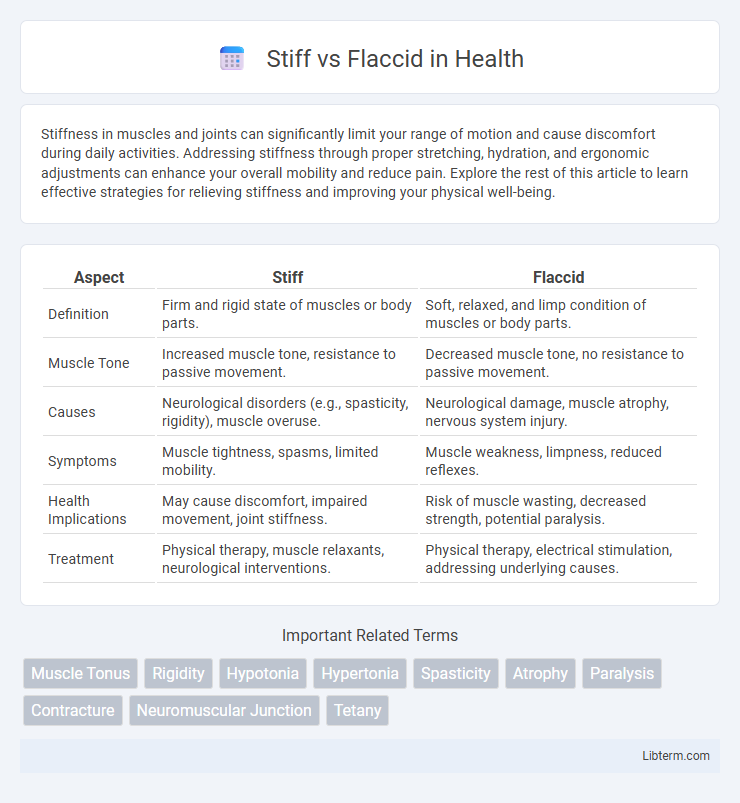Stiffness in muscles and joints can significantly limit your range of motion and cause discomfort during daily activities. Addressing stiffness through proper stretching, hydration, and ergonomic adjustments can enhance your overall mobility and reduce pain. Explore the rest of this article to learn effective strategies for relieving stiffness and improving your physical well-being.
Table of Comparison
| Aspect | Stiff | Flaccid |
|---|---|---|
| Definition | Firm and rigid state of muscles or body parts. | Soft, relaxed, and limp condition of muscles or body parts. |
| Muscle Tone | Increased muscle tone, resistance to passive movement. | Decreased muscle tone, no resistance to passive movement. |
| Causes | Neurological disorders (e.g., spasticity, rigidity), muscle overuse. | Neurological damage, muscle atrophy, nervous system injury. |
| Symptoms | Muscle tightness, spasms, limited mobility. | Muscle weakness, limpness, reduced reflexes. |
| Health Implications | May cause discomfort, impaired movement, joint stiffness. | Risk of muscle wasting, decreased strength, potential paralysis. |
| Treatment | Physical therapy, muscle relaxants, neurological interventions. | Physical therapy, electrical stimulation, addressing underlying causes. |
Understanding Stiffness and Flaccidity
Stiffness refers to the resistance of a material or tissue to deformation, often resulting from increased rigidity or muscle contraction, whereas flaccidity denotes a lack of firmness or muscle tone, typically caused by decreased muscle tension or neurological impairment. Understanding stiffness involves analyzing factors such as muscle fiber composition, connective tissue structure, and neural stimulation, which contribute to rigidity and limited flexibility. Flaccidity is characterized by diminished muscle responsiveness and reduced elasticity, often observed in conditions involving nerve damage or muscular disorders.
Key Differences Between Stiff and Flaccid States
Stiff and flaccid refer to two distinct states of muscle or tissue rigidity, where stiffness indicates firmness and resistance to deformation while flaccidity denotes softness and lack of tension. Key differences include muscle tone, with stiff muscles exhibiting high tone and tension, whereas flaccid muscles show reduced or absent tone leading to limpness. Physiological conditions such as spasticity or hypotonus often cause these contrasting states, influencing movement and functional capabilities significantly.
Causes of Stiffness
Stiffness typically arises from muscle strain, inflammation, or joint conditions such as arthritis, which restrict normal movement and cause discomfort. Neurological disorders like Parkinson's disease or multiple sclerosis can also lead to increased muscle tone and rigidity. Other causes include prolonged immobility, dehydration, and electrolyte imbalances, which impact muscle function and contribute to stiffness.
Causes of Flaccidity
Flaccidity, characterized by decreased muscle tone and weakness, is commonly caused by nerve damage, particularly to the lower motor neurons or peripheral nerves. Conditions such as spinal cord injuries, stroke affecting the motor pathways, or diseases like Guillain-Barre syndrome disrupt normal neural input, leading to muscle flaccidity. Other causes include muscle disorders like muscular dystrophy and metabolic imbalances, which impair muscle function and tone.
Symptoms and Signs of Stiff vs Flaccid
Stiff muscles typically present with increased muscle tone, resistance to passive movement, and may cause rigidity or cramping, often accompanied by difficulty in initiating motion. Flaccid muscles show decreased or absent muscle tone, resulting in limpness, reduced reflexes, muscle weakness, and impaired voluntary movement. Distinguishing symptoms include rigidity and spasms in stiff muscles versus hypotonia and muscle atrophy in flaccid conditions.
Medical Conditions Associated With Stiffness
Stiffness in muscles and joints commonly arises from medical conditions such as arthritis, multiple sclerosis, and Parkinson's disease, which impact mobility and cause discomfort. Muscle stiffness is also prevalent in disorders like fibromyalgia and myofascial pain syndrome, where abnormal muscle tension persists. Chronic inflammation and neurological impairments contribute significantly to the sensation of stiffness, requiring targeted medical evaluation and treatment.
Medical Conditions Associated With Flaccidity
Flaccidity, characterized by reduced muscle tone and weakness, is commonly associated with neurological disorders such as Guillain-Barre syndrome, spinal cord injuries, and peripheral neuropathies. Medical conditions like stroke, poliomyelitis, and multiple sclerosis can also lead to muscle flaccidity due to impaired nerve signals. In contrast, stiffness or rigidity typically involves hypertonia seen in diseases like Parkinson's or cerebral palsy, highlighting differing underlying pathophysiologies.
Diagnostic Approaches
Diagnostic approaches for differentiating stiff versus flaccid conditions primarily involve physical examination assessing muscle tone and reflexes; increased tone and hyperreflexia indicate stiffness, while decreased tone and hyporeflexia suggest flaccidity. Electromyography (EMG) and nerve conduction studies provide objective data by identifying abnormal muscle activity patterns and nerve signal transmission deficits. Imaging techniques like MRI help exclude structural causes affecting the central or peripheral nervous system contributing to these motor abnormalities.
Treatment and Management Options
Treatment and management options for stiff conditions often involve physical therapy, muscle relaxants, and anti-inflammatory medications to improve mobility and reduce discomfort. For flaccid muscle conditions, therapies may include neuromuscular stimulation, electrical muscle stimulation, and targeted rehabilitation exercises designed to restore muscle tone and strength. In severe cases, surgical interventions or the use of assistive devices might be necessary to enhance functional outcomes and patient quality of life.
Prevention and Lifestyle Tips
Maintaining cardiovascular health through regular exercise and a balanced diet rich in antioxidants supports stiff artery prevention. Avoiding smoking, managing stress, and controlling blood sugar levels reduce risks associated with flaccid vascular walls. Adequate hydration and consistent sleep patterns further enhance arterial elasticity and overall vascular function.
Stiff Infographic

 libterm.com
libterm.com